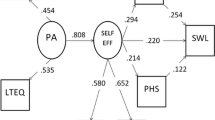Abstract
Aim
A low level of physical activity is a risk factor for several chronic diseases, and evidence suggests that physical activity levels are in decline. Reversing this trend will involve a change in behaviour for most people. However, the associations between many psychosocial determinants and physical activity are not well understood. This study aims to examine the relationship between self-reported physical activity and perceived self-efficacy and stages of change.
Subjects and methods
Students attending a third-level college in Dublin, Ireland, were recruited to participate in the study (n=201, mean age 20.7 years). Physical activity was assessed with the use of the long format, self-administered International Physical Activity Questionnaire (IPAQ), and subjects were assigned to tertiles of activity. Self-efficacy and stages of change (in relation to increasing physical activity) were assessed by means of a questionnaire.
Results
Males reported more physical activity, had higher self-efficacy and were more likely to be in the action or maintenance stages of change. The stages of change were positively correlated with tertiles of reported activity (P<0.001) in both genders. The correlation between activity and positive self-efficacy was significant (P<0.001) for males but not for females.
Conclusion
Self-efficacy may be an important determinant of physical activity, and awareness of the stages of change may also help to explain physical activity although this effect appears to differ by gender. Physical activity is a complex behaviour, and the factors that determine it must be better understood if health promotion strategies to increase it are to be successful.


Similar content being viewed by others
References
Casperson CJ, Powell KE, Christenson GM (1985) Physical activity, exercise and physical fitness: definitions and distinctions for health-related research. Public Health Rep 100:126–130
CDC (1996) Physical activity and health: a report of the surgeon general. U.S. Department of Health and Human Services, Atlanta, GA
Clancy P, Wall J (2000) Social background of higher education entrants. Higher Education Authority, Dublin
Craig CL, Marshall AL, Sjostrom M, Bauman AE, Booth ML, Ainsworth BE, Pratt M, Ekelund U, Yngve A, Sallis JF, Oja P (2003) International physical activity questionnaire: 12- country reliability and validity. Med Sci Sports Exerc 35:1381–1395
Currie C, Roberts C, Morgan A, Smith R, Settertobulte W, Samdal O, Barnekow Rasmussen V (2004) Young people’s health in context, health behaviour in school-aged children study: international report from the 2001/2002 survey. Health policy for children and adolescents No.4. WHO Regional Office for Europe, Copenhagen, Denmark
European Opinion Research Group (EEIG) (2005) Special eurobarometer 183/Wave 58.2-smoking and the environment. http://europa.eu.int/comm/public_opinion/archives/ebs/ebs_183_en.pdf. Accessed March 15, 2005
Harrington KE, Robson PJ, Kiely M, Livingstone MB, Lambe J, Gibney MJ (2001) The north/south Ireland food consumption survey: survey design and methodology. Public Health Nutr 4(5A):1037–1042
Kearney JM, de Graaf C, Damkjaer S, Engstrom LM (1999) Stages of change towards physical activity in a nationally representative sample in the European Union. Public Health Nutr 2(1A):115–124
Kelleher C, Nic GabhainnS, Friel S, Corrigan H, Nolan G, Sixsmith J, Walsh O, Cooke M (2003) The national health and lifestyle surveys (II) survey of lifestyle, attitudes and nutrition (SLÁN) and the Irish health behaviour in school-aged children survey (HBSC). Department of Health and Children, Dublin
Marcus BH, Banspach SW, Lefebvre RC, Rossi JS, Carleton RA, Abrams DB (1992) Using the stages of change model to increase the adoption of physical activity among community participants. Am J Health Promot 6:424–429
Margetts BM (2004) Public health nutrition strategies for intervention at the individual level. In: Gibney MJ, Margetts BM, Kearney JM, Arab L (eds) Public Health Nutrition. Blackwell Publishing, Oxford, pp 120–132
Pavlou KN, Krey S, Steffee WP (1989) Exercise as an adjunct to weight loss and maintenance in moderately obese subjects. Am J Clin Nutr 49(5 Suppl):1115–1123
Rimal RN (2001) Longitudinal influences of knowledge and self-efficacy on exercise behavior: tests of a mutual reinforcement model. J Health Psychol 6:31–46
World Health Organization (2002) The World Health Report 2002: reducing risks, promoting healthy life. World Health Organization, Geneva
Acknowledgements
Mairéad Stack in the Dublin Institute of Technology supervised data collection. Prof Olle Carlsson gave statistical guidance.
Author information
Authors and Affiliations
Corresponding author
Rights and permissions
About this article
Cite this article
Patterson, E., McGeough, D., Cannon, E. et al. Self-efficacy, stages of change and physical activity in Irish college students. J Public Health 14, 81–86 (2006). https://doi.org/10.1007/s10389-006-0028-6
Received:
Accepted:
Published:
Issue Date:
DOI: https://doi.org/10.1007/s10389-006-0028-6




